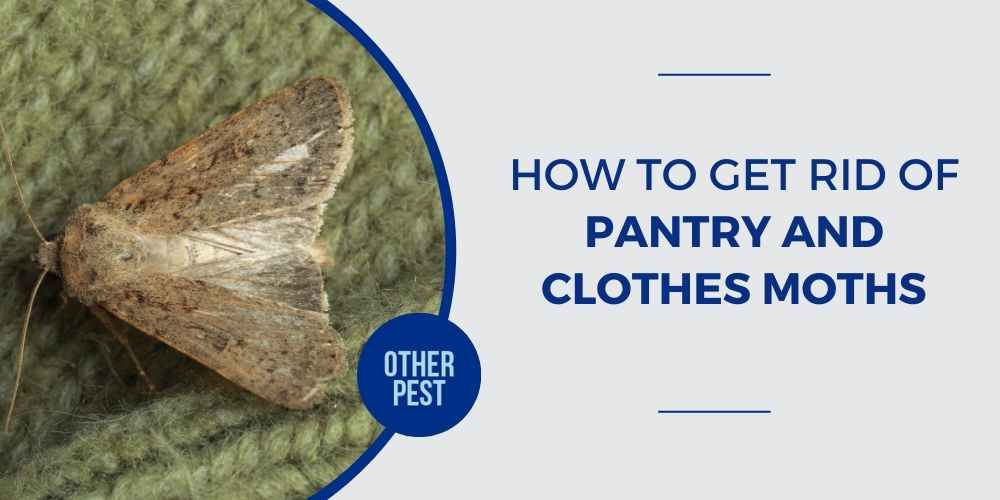Imagine that first cool day of fall (we know it’s a tough ask during the heat of summer). You open your dresser drawer to grab a sweater. It’s the first time since early spring. When you pull it out and hold it up you discover it’s covered in tiny holes. Did little elves sneak in with their scissors to chop it up in the middle of the night? Probably not. It’s more likely your sweater drawer has been visited by a moth.
Moths can be seen year-round, but they thrive during Arizona’s hot summer months, especially during a good monsoon season. There are more than two thousand moth species recorded in Arizona and different species cause different problems. In this blog, we will examine the two main culprits creating havoc in most households: pantry moths and clothes moths.
Pantry Moths
As the name suggests, these pests are primarily found indoors where dry foods are stored, such as kitchen cabinets or pantries. Pantry moths pose a threat to various food items including grains, bread, pasta and flour, which they will feed on. Once moths gain access to food storage areas, they will leave traces of fecal matter, shed skin and lay eggs. As disgusting as finding fecal matter and moth eggs in your flour and food containers sounds, the good news is that moths are not a source for spreading diseases. While they may not be a source for illnesses, if any food item is contaminated by pantry moths it should be thrown away immediately. Knowing the signs that pantry moths may be in your home and taking preventative measures to keep them away, can minimize potential damage and food waste.
Signs of Pantry Moths
Aside from seeing moths flying in and around storage areas, common signs a pantry or kitchen cabinet has unwanted guests include:
Appearance of stringy webbing on cabinets, ceiling corners or hanging from food products
Tiny holes located on dry food packaging
Eliminating Pantry Moths
After spotting pantry moths, it is important to take the necessary steps to get rid of them and prevent them from returning in the future. Start with thoroughly cleaning the pantry. It is the most crucial step in eliminating pantry moths. While cleaning, inspect food packages and containers to assess the severity of the moth problem. A deep cleaning is also effective for deterring other insects from invading your food.
Steps for cleaning the pantry:
- Remove all food and other items from shelves and around walls.
- Inspect food and throw away anything that has been contaminated.
- Thoroughly vacuum the pantry (baseboards, ceiling, door hinges, and shelves).
- Immediately dispose of contents from the vacuum.
- Use hot water and a small amount of dish soap and wipe all surfaces.
- Continue to closely monitor for signs of moth damage.
Clothes Moths
Another appropriately named moth species is the clothes moth. Clothes moths are attracted to the keratin found in fabric and hair. Some of their favorite household materials to snack on include silk, leather, wool, animal hair and human hair. Clothes moths are small, measuring only about one-quarter inch long with a half-inch wingspan, making them hard to find.
Signs of Clothes Moths
Adult clothes moths are harder to see than other moths, as their dark brown color allows them to camouflage themselves and blend in with dark closets and drawers. Clothes moth larvae are even harder to spot and they actually cause most of the damage. Small holes or tunnels running through clothing are the biggest sign that clothes moths have moved in. Other signs left behind include:
- Small eggs/larvae found on carpet or clothing
- Appearance of stringy webbing on clothes, around shelves or in corners
Eliminating Clothes Moths
The longer clothes moths are allowed to hide in a home the more damage they cause. Fortunately, getting rid of moths is fairly easy. Here are the most immediate steps to take:
- Check all clothes in closets, drawers and other area.
- Thoroughly wash all clothing in hot water to kill any eggs.
- If the item cannot be washed by hand or in the washing machine, consider freezing items to get rid of eggs.
- Vacuum and disinfect all closets, using attachments to clean everything out of corners and in and around the ceiling .
How to prevent moths from returning
Properly Store Food & Clothes
Keeping kitchen and food storage areas clean will help in keep pantry moths away. After a food item is opened, store it in an airtight container. Avoid storing food in containers with twist-on lids because moths will lay their eggs along the rims and young larvae can even squeeze under jar lids. Make sure there aren’t any rogue crumbs left on kitchen counters or cabinet shelves.
To keep clothes moths from chowing down on your favorite garments, keep clothing – especially wool in sealed boxes or bags. Any clothing that you are not going to wear for a while can be packed and stored in tightly sealed plastic bins or bagged securely. Vacuum-sealed garment bags are great for special items. It is also important to regularly clean areas where clothes are stored, as well as periodically wash clothes that aren’t sealed away. If washing isn’t possible, another option is to take clothes out of where they are stored and shake them free of dust and potential moths.
Repelling Scents
Another effective option for keeping moths away is using scents. Moths will avoid the smell of lavender, bay leaves, mint and cedar. Spreading sachets of dried lavender or cedar chips in clothing storage bins and closets can prevent moths from making themselves comfortable. Mint and bay leaves are perfect for kitchen areas – think herb garden on your windowsill or kitchen counter. Essential oils and scented sprays can also be effective.
Light Traps
Insect light traps are another effective tool for keeping the moth population around your home and yard in check – especially when placed on a patio. The Dynatrap is popular for patios and garden areas. All you need is access to an electrical outlet to plug it in and it goes to work instantly. Every few months the bulb may need to be replaced depending on how often it’s used, and about every two months the lure may need replacing, depending on bug volume, These are both a small cost for keeping moths and other flying insects away. Fortunately, Bug & Weed Mart carries all of the products and supplies you need for keeping moths away.
Bug & Weed Mart offers a vast array of safe, economical DIY pest and weed control solutions. Stop by one of our Valley-wide locations and one of our experienced team members will be happy to help you solve any pest or weed problems you have.

